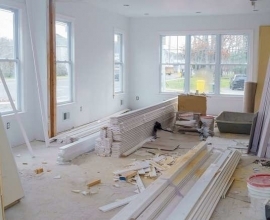New year, new home for Princeton’s first aid squad
On December 13, the Princeton First Aid & Rescue Squad, an independent nonprofit, moved from a 1963 building at the corner of Harrison and Clearview to its brand-new building at 2 Mount Lucas Road.
“We provide emergency medical services and rescue services to the entire Princeton community; there is no other ambulance service that covers Princeton for 911 calls,” says Mark Freda, who became president a year and a half ago. They have eight or nine emergencies each day, with 3,069 total trips in 2018 and just under 3,000 in 2019.
“In the old building there was one very small office that 10 or 11 people shared,” Freda says. When he described the multi-use training room — which also served as a meeting room, dining room, and workspace for the development person, and housed most of the organization’s storage — as “very inefficient and difficult,” he was being kind.
Volunteers spent most of their time in the basement of the old building, under dreary old fluorescent lighting. There were only two bunkrooms, with two beds each, and only one shower.
But it wasn’t just the human spaces that were too small. Back in 1963 when the old building opened, Freda says, the ambulances, made by Cadillac, were similar in size to a hearse. Ambulances today are wider, higher, and longer. “When we would back in and out there was literally an inch on either side of the mirrors. Half of the vehicles were either outside or we had a boat on a trailer at the firehouse on Harrison Street.” In the new building, he says, “the biggest difference is that all our vehicles, trailers, and boats are now inside and are all here.”
“The [old] building was really good for the 1960s, but as the organization grew, as demand grew, as the number of calls and training grew, we rapidly outgrew the building,” Freda says.
Aware of the serious downsides of their existing space, 16 years ago they started interviewing architects and selected Albany, New York-based Pacheco Ross Architects, which later merged with H2M, to start the design process and create a conceptual plan that would specify the space needs for different functions and their relationships to each other.
They looked at multiple properties in town: on Bayard Lane, the Valley Road School building, and the old PFARS site (which included the old building as well as two residential properties on Clearview they had purchased, which they sold to the municipality). Ultimately they decided on 2 Mt. Lucas Road, the site of the township’s public works facility, which they had considered earlier when a joint borough-township public works facility on River Road was being talked about but did not come to fruition.
In 2014 they signed a memorandum of understanding with the municipality, which was updated in 2016.
Their exploration of different potential sites meant they were able to compress the time that would have usually been required to transform the conceptual design into construction drawings.
“Each time we did a new plan, we put more detail in,” Freda says. “By the time got here, [we had] a pretty detailed schematic plan: we had worked out the size of the building, how it would function, what functions needed to be next to each other, and how they related to each other.” C. Raymond Davis served as the general contractor for the new building.
“One of the big design factors was to make it welcoming” to PFARS’s eleven paid staff — Freda, a development officer, the chief, and eight emergency medical technicians — and 65 volunteers. The goal was to “make it a place that our volunteers want to come and be in and a place where our career people don’t mind coming to work.”
For volunteers the new building has a great room with television, comfy sofas, and recliners; an adjacent dining room and kitchen; a quiet study room with extra insulation; and an exercise room. They also have six rooms, each with a bunkbed, and two fully equipped bathrooms with showers. Since an overnight crew is usually three or four people, usually each can have their own room — but if a hurricane or large snowstorm is expected, 12 people can be accommodated.
The staff space includes three individual offices as well as an open office area; two bathrooms with three stalls each; a separate conference room; and a large training room with two sizeable closets.
PFARS runs two courses a year to train EMTs (the course runs for three and a half months, two nights a week and all day Saturday). “Most of the people who go through are people who are joining our squad,” Freda says. “They learn on our equipment, meet our people while they are in training, and when they’re done, they’re familiar with our organization and equipment.”
One big closet has all the training aids for the EMT class, and the other holds training materials for the in-house module program, which involves training on specific equipment and procedures, for example, vacuum splints for a broken femur.
The large training room is also used as a meeting room and for community training, for example, CPR training for police officers. “It’s great,” Freda says. “We want people to come into the building and be familiar with us, especially other emergency services. It helps build better relations.”
The bays lining one side of the new building hold a fleet of four ambulances, a rescue truck, a technical rescue trailer with supplies and material for a structure or trench collapse, two four-wheel drive vehicles, one used primarily for the boat.
The new building also has an alerting system, with a blue light, speakers, and monitors throughout the building. “No matter where we are, we know there’s a call,” Freda says, noting that the monitors display the details and location of each call, received via a computer-aided dispatch system from the police departments.
The vast majority of their calls end up at the Princeton Hospital. If there is a severe trauma, they may go to Helene Fuld in Trenton or Robert Wood Johnson in New Brunswick, both of which are trauma centers. Or if someone’s personal doctor is at Capital Health in Hopewell, they may go there.
PFARS hired a full-time development officer three years ago to raise money for the new building and now to expand support beyond the “small group of local citizens that helped us continue to raise money.”
They are exploring individuals, foundations, and corporations for support. The $12 million fund drive includes both the money necessary to build the new building and endowments to help meet future operating costs for the building. Freda notes that they have taken a number of steps to help keep operating costs down: using LED lighting; making sure the building is well insulated, “over and above code requirements”; and installing a solar panel system on the roof.
Volunteers come to PFARS for different reasons. College-age volunteers may be interested in a medical career and want to find out whether that is something they really want to do. “They find out pretty quickly in an ambulance, where there is someone who is really hurt and in grave condition,” Freda says. He adds that also “there are lots of people who still like to help other people.”
For people who do express interest, there is a detailed process for becoming a member. First, they are told all the requirements, the training they will get, and the things they are likely to have to do. People also must complete a checklist. “If you have too many Nos that’s probably a pretty good clue that you’re not going to do this,” Freda says.
As medical knowledge evolves, the role of EMT changes. Over the last 30 years, EMTs have been allowed to do many more things, for example, administering NARCAN to people who are overdosing. As a result, Freda says, training changes on a regular basis.
Freda came to PFARS at age 18 after colleagues from the all-volunteer fire department encouraged him to join. “It was a great experience, especially for a young person — there are a lot of life lessons,” he says.
First of all, when you start to ride ambulances, people depend on you. “It’s not something that you join and show up once in a while. You have to be fully committed to what we do,” he says.
Second, “you’re put into a position of extreme stress, and you have to take total responsibility for what you are doing. If you have a very ill person, you are responsible for their life. One day you’re doing CPR on somebody; another day, somebody has a badly broken limb, and you’re setting that. You might be inside a vehicle while someone is trapped, and you’re trying to calm the person while using a hydraulic rescue tool to free them.”
Third, “you develop skills and have meaningful experiences that you are not going to get in other volunteer opportunities,” Freda says. “For a young person you have to grow tremendously and mature.”
Young people also get to take on positions of responsibility within the squad and get experience in budgeting, communications, and all the sorts of tasks needed to run an organization. “Here’s the experience that is going to help them in their entire work career. They will get a leg up on other people,” Freda says.
Thinking back to his first serious calls, Freda says, “The first time you’re doing CPR on somebody, that person is literally dead and you’re trying to bring that person back.” But he found meaningful even simple things, like calming a person who had fallen but was not badly hurt.
Sometimes a person who he helped three decades ago still knows his name. “When someone is really in need of help and you help them, they remember that for a long time,” he says.
Freda still volunteers, but he no longer rides ambulances, because when he was working in New York for a number of years, keeping up with training was difficult. But he does still ride the large rescue truck that accompanies ambulances to a car wreck.
Freda served as volunteer president of PFARS 14 or 15 times while he did his real job in facilities management, overseeing the renovation of buildings. When it was time for construction of the new building, he was between jobs and people on the squad suggested it was time to actually hire him as president. He happily agreed. “I love the organization, and realistically I saved the organization a lot of money,” he says, noting that the squad would have had to spend a lot more to hire a professional project manager.
PFARS is also “trying to be as sustainably responsible as possible,” Freda says. They have applied, for example, for a state grant that they are likely to get that will allow them to put two electrical-vehicle charging stations in the parking lot, for use by PFARS members and the public. They have also used bamboo instead of wood for floors.
Princeton administrator Marc Dashield says that a task force has been appointed to evaluate alternatives for the three-quarter-acre site of the old building. The town bought the building from PFARS as a way to assist them, Dashield says. “We purchased the property when they did the transfer for two purposes: if we decide that we will use it for a purpose, we will use it; if not, we will then sell the property and recoup our funds.” The old headquarters, he adds, is a usable structure.
Now that the building is done, Freda will be focusing on the administrative side, for example, improving the annual fund drive; and developing and educating the outside board of trustees.
Source: https://bit.ly/2SEBzJH







